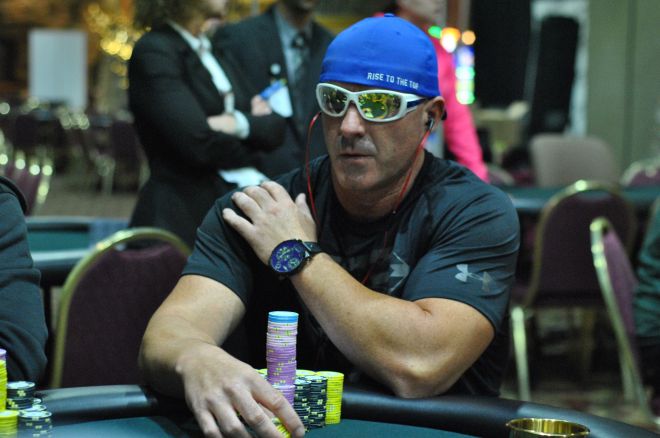Four-Betting, Then Folding: A Pot Odds Problem

Covering live poker tournaments for a living affords me the opportunity to see countless thousands of hands played out, many of which offer interesting and potentially valuable insights into how players — both amateurs and professionals — play the game. In this ongoing series, I’ll highlight hands I’ve seen at the tournaments I’ve covered and see if we can glean anything useful from them.
The Scene
We’re at Mid-States Poker Tour Canterbury Park. It’s deep in the $1,100 buy-in tournament, with 15 players remaining. There’s more than $106,000 up top, with the next elimination receiving $4,156. The general feel of the action right now has been tight, with nobody really getting stacks in light as the final table nears, leading to shorter average stacks than one might expect.
Current stakes are 15,000/30,000/4,000 but the 20,000/40,000/5,000 level looms in a few minutes, so the pressure is on for everyone as the average right now is under 20 big blinds and it will be under 15 big blinds after the level changes.
The Action
Joel Klipping (pictured below), who had been toting a big stack for most of the tournament and had just under 700,000 to start the hand, opened for 88,000 in the cutoff. Todd “Sharkslayerr” Breyfogle (pictured above), a regular on the MSPT circuit, three-bet to 190,000 on the button. Breyfogle started the hand with 603,000.
After the blinds folded, Klipping four-bet to 400,000. Breyfogle instantly shoved all in, and Klipping tanked for a few minutes before folding 8♠8♣ face-up. Breyfogle showed him Q♠Q♣ and collected the pot.
Concept and Analysis
The key here is one of the basic principles of poker — understanding pot odds.
As all of the action was preflop, this one is fairly simple to run down. Klipping makes a largish standard open (to nearly 3x the big blind) from the cutoff with a solid hand, and Breyfogle three-bets with a big pair. Breyfogle is way ahead of Klipping’s range and is looking to get stacks in.

Klipping then opts to four-bet, which is completely understandable. Unless you are up against a total nit on the button, you will often have the best hand in this spot against a reraise. With as much three-betting as there is nowadays in late position, eights have plenty of value, especially when stacks are deep enough that your opponent might fold. Breyfogle is certainly aware enough to make some light three-bets if he thinks he can make his opponent lay down hands.
Once Breyfogle shoves, however, things go awry for Klipping.
Simple math at that point dictates a mandatory call. Klipping has put in 400,000 and needs to call 203,000 more. The table is either seven or eight-handed so there’s just under 1.1 million in the pot at the very least, which means Klipping is getting more than 5-to-1 on his money.
Even in the worst-case scenario, if Breyfogle has a bigger pair 100 percent of the time, Klipping is still getting correct odds to call. Hardly anyone is nitty enough that they’re going to fold ace-king for their last 20 big blinds in a cutoff-versus-button battle, so it’s likely Klipping’s true odds are much better than that.
Klipping likely felt vindicated by his fold when he was shown the bigger pocket pair, but it’s crucial to have a rough mental count of the pot so you know when the amount in there compels you to gamble. Left with just seven big blinds after the level went up, Klipping was unable to recover, busting in 13th for $4,156. Breyfogle, meanwhile, became one of the leaders with nearly 30 big blinds and parlayed that into a fifth-place finish for $23,689.
Want to stay atop all the latest in the poker world? If so, make sure to get PokerNews updates on your social media outlets. Follow us on Twitter and find us on both Facebook and Google+!








